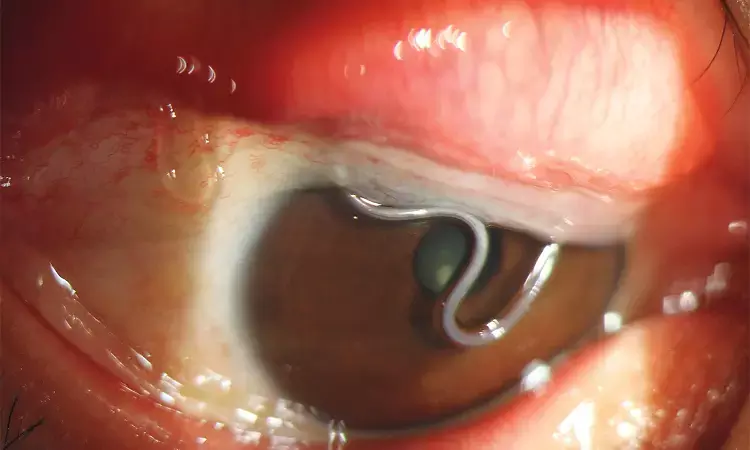- Home
- Medical news & Guidelines
- Anesthesiology
- Cardiology and CTVS
- Critical Care
- Dentistry
- Dermatology
- Diabetes and Endocrinology
- ENT
- Gastroenterology
- Medicine
- Nephrology
- Neurology
- Obstretics-Gynaecology
- Oncology
- Ophthalmology
- Orthopaedics
- Pediatrics-Neonatology
- Psychiatry
- Pulmonology
- Radiology
- Surgery
- Urology
- Laboratory Medicine
- Diet
- Nursing
- Paramedical
- Physiotherapy
- Health news
- Fact Check
- Bone Health Fact Check
- Brain Health Fact Check
- Cancer Related Fact Check
- Child Care Fact Check
- Dental and oral health fact check
- Diabetes and metabolic health fact check
- Diet and Nutrition Fact Check
- Eye and ENT Care Fact Check
- Fitness fact check
- Gut health fact check
- Heart health fact check
- Kidney health fact check
- Medical education fact check
- Men's health fact check
- Respiratory fact check
- Skin and hair care fact check
- Vaccine and Immunization fact check
- Women's health fact check
- AYUSH
- State News
- Andaman and Nicobar Islands
- Andhra Pradesh
- Arunachal Pradesh
- Assam
- Bihar
- Chandigarh
- Chattisgarh
- Dadra and Nagar Haveli
- Daman and Diu
- Delhi
- Goa
- Gujarat
- Haryana
- Himachal Pradesh
- Jammu & Kashmir
- Jharkhand
- Karnataka
- Kerala
- Ladakh
- Lakshadweep
- Madhya Pradesh
- Maharashtra
- Manipur
- Meghalaya
- Mizoram
- Nagaland
- Odisha
- Puducherry
- Punjab
- Rajasthan
- Sikkim
- Tamil Nadu
- Telangana
- Tripura
- Uttar Pradesh
- Uttrakhand
- West Bengal
- Medical Education
- Industry
Case of Ocular Thelaziasis reported in NEJM

Courtesy NEJM
Dr Zijing Huang and Dr Weiqi Chen at Joint Shantou International Eye Center, Shantou, China have reported a case of Ocular Thelaziasis that has been published in the New England journal of Medicine.
Thelaziasis is an Arthropod-born disease of the eye and adnexa caused by Thelazia callipaeda which is is often under-reported and not been given its due clinical importance.It is a nematode parasite transmitted by drosophilid flies to carnivores and humans. Its distribution is mainly confined to South Asian countries and Russia, and therefore it is commonly known as Oriental Eye worm.
Thelazia callipaeda was first described in 1910 from a Chinese dog and the first case of human Thelaziasis was reported in 1917, wherein four worms were extracted from the eye of Coolie in Peiping, China. Later on a case of Human Thelaziasis (HT) was reported in India from Yeroaud, Salem District in 1948.
Thelazia callipaeda (Spirurida, Thelaziidae) infects a range of definitive hosts, such as dogs, cats, foxes, rabbits, and humans; this spiruroid nematode is seen in the conjunctival sac, lacrimal gland, and lacrimal duct of these mammals.Ocular features of human Thelaziasis include excess lacrimation, irritation, conjunctivitis, keratitis, corneal ulcers, and ectropian.
According to history, a 34-year-old man presented to the ophthalmology clinic and reported having the sensation of a foreign body and itching in his right eye. He had no known medical history, and he lived on a farm with his dog. Examination with slit-lamp microscopy showed two live worms beneath the upper eyelid. A topical anesthetic was administered, and the worms were removed with the use of a fine forcep. The worms were sent to the university parasitology laboratory for examination and were identified as Thelazia callipaeda. A diagnosis of ocular thelaziasis was made. T. callipaeda, a parasitic worm that is carried and transmitted by drosophilid flies, feeds on eye secretions and deposits larvae in the eyes of the definitive host, typically a dog but occasionally a human. At follow-up 1 month after the worms had been removed, the pruritus had resolved and the patient no longer had the sensation of a foreign body in his eye. He has not reported recurrence.
Dr Kartikeya Kohli is an Internal Medicine Consultant at Sitaram Bhartia Hospital in Delhi with super speciality training in Nephrology. He has worked with various eminent hospitals like Indraprastha Apollo Hospital, Sir Gangaram Hospital. He holds an MBBS from Kasturba Medical College Manipal, DNB Internal Medicine, Post Graduate Diploma in Clinical Research and Business Development, Fellow DNB Nephrology, MRCP and ECFMG Certification. He has been closely associated with India Medical Association South Delhi Branch and Delhi Medical Association and has been organising continuing medical education programs on their behalf from time to time. Further he has been contributing medical articles for their newsletters as well. He is also associated with electronic media and TV for conduction and presentation of health programs. He has been associated with Medical Dialogues for last 3 years and contributing articles on regular basis.
Dr Kamal Kant Kohli-MBBS, DTCD- a chest specialist with more than 30 years of practice and a flair for writing clinical articles, Dr Kamal Kant Kohli joined Medical Dialogues as a Chief Editor of Medical News. Besides writing articles, as an editor, he proofreads and verifies all the medical content published on Medical Dialogues including those coming from journals, studies,medical conferences,guidelines etc. Email: drkohli@medicaldialogues.in. Contact no. 011-43720751


